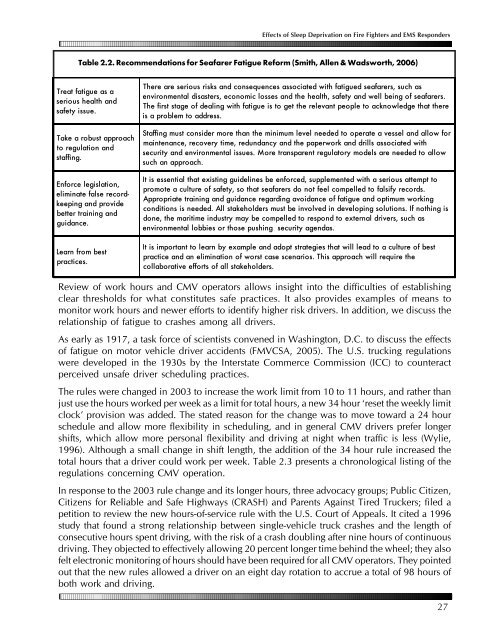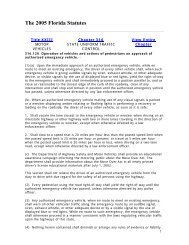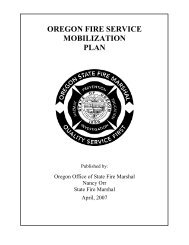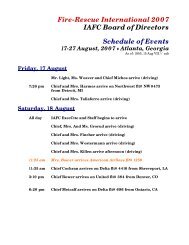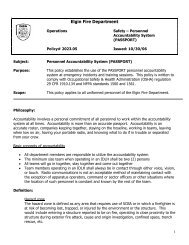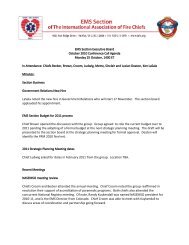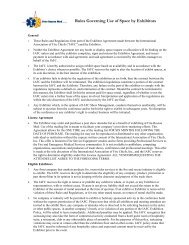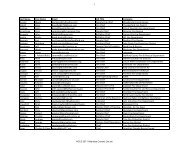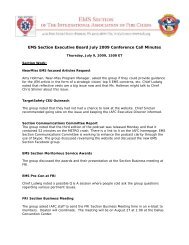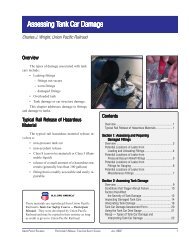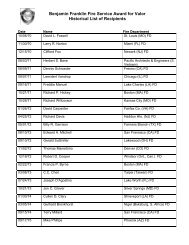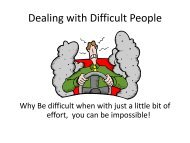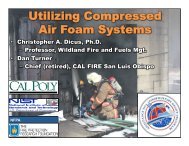Effects of Sleep Deprivation on Fire Fighters and EMS ... - NAEMT
Effects of Sleep Deprivation on Fire Fighters and EMS ... - NAEMT
Effects of Sleep Deprivation on Fire Fighters and EMS ... - NAEMT
You also want an ePaper? Increase the reach of your titles
YUMPU automatically turns print PDFs into web optimized ePapers that Google loves.
<str<strong>on</strong>g>Effects</str<strong>on</strong>g> <str<strong>on</strong>g>of</str<strong>on</strong>g> <str<strong>on</strong>g>Sleep</str<strong>on</strong>g> <str<strong>on</strong>g>Deprivati<strong>on</strong></str<strong>on</strong>g> <strong>on</strong> <strong>Fire</strong> <strong>Fighters</strong> <strong>and</strong> <strong>EMS</strong> Resp<strong>on</strong>ders<br />
Table 2.2. Recommendati<strong>on</strong>s for Seafarer Fatigue Reform (Smith, Allen & Wadsworth, 2006)<br />
Treat fatigue as a<br />
serious health <strong>and</strong><br />
safety issue.<br />
Take a robust approach<br />
to regulati<strong>on</strong> <strong>and</strong><br />
staffing.<br />
Enforce legislati<strong>on</strong>,<br />
eliminate false recordkeeping<br />
<strong>and</strong> provide<br />
better training <strong>and</strong><br />
guidance.<br />
Learn from best<br />
practices.<br />
There are serious risks <strong>and</strong> c<strong>on</strong>sequences associated with fatigued seafarers, such as<br />
envir<strong>on</strong>mental disasters, ec<strong>on</strong>omic losses <strong>and</strong> the health, safety <strong>and</strong> well being <str<strong>on</strong>g>of</str<strong>on</strong>g> seafarers.<br />
The first stage <str<strong>on</strong>g>of</str<strong>on</strong>g> dealing with fatigue is to get the relevant people to acknowledge that there<br />
is a problem to address.<br />
Staffing must c<strong>on</strong>sider more than the minimum level needed to operate a vessel <strong>and</strong> allow for<br />
maintenance, recovery time, redundancy <strong>and</strong> the paperwork <strong>and</strong> drills associated with<br />
security <strong>and</strong> envir<strong>on</strong>mental issues. More transparent regulatory models are needed to allow<br />
such an approach.<br />
It is essential that existing guidelines be enforced, supplemented with a serious attempt to<br />
promote a culture <str<strong>on</strong>g>of</str<strong>on</strong>g> safety, so that seafarers do not feel compelled to falsify records.<br />
Appropriate training <strong>and</strong> guidance regarding avoidance <str<strong>on</strong>g>of</str<strong>on</strong>g> fatigue <strong>and</strong> optimum working<br />
c<strong>on</strong>diti<strong>on</strong>s is needed. All stakeholders must be involved in developing soluti<strong>on</strong>s. If nothing is<br />
d<strong>on</strong>e, the maritime industry may be compelled to resp<strong>on</strong>d to external drivers, such as<br />
envir<strong>on</strong>mental lobbies or those pushing security agendas.<br />
It is important to learn by example <strong>and</strong> adopt strategies that will lead to a culture <str<strong>on</strong>g>of</str<strong>on</strong>g> best<br />
practice <strong>and</strong> an eliminati<strong>on</strong> <str<strong>on</strong>g>of</str<strong>on</strong>g> worst case scenarios. This approach will require the<br />
collaborative efforts <str<strong>on</strong>g>of</str<strong>on</strong>g> all stakeholders.<br />
Review <str<strong>on</strong>g>of</str<strong>on</strong>g> work hours <strong>and</strong> CMV operators allows insight into the difficulties <str<strong>on</strong>g>of</str<strong>on</strong>g> establishing<br />
clear thresholds for what c<strong>on</strong>stitutes safe practices. It also provides examples <str<strong>on</strong>g>of</str<strong>on</strong>g> means to<br />
m<strong>on</strong>itor work hours <strong>and</strong> newer efforts to identify higher risk drivers. In additi<strong>on</strong>, we discuss the<br />
relati<strong>on</strong>ship <str<strong>on</strong>g>of</str<strong>on</strong>g> fatigue to crashes am<strong>on</strong>g all drivers.<br />
As early as 1917, a task force <str<strong>on</strong>g>of</str<strong>on</strong>g> scientists c<strong>on</strong>vened in Washingt<strong>on</strong>, D.C. to discuss the effects<br />
<str<strong>on</strong>g>of</str<strong>on</strong>g> fatigue <strong>on</strong> motor vehicle driver accidents (FMVCSA, 2005). The U.S. trucking regulati<strong>on</strong>s<br />
were developed in the 1930s by the Interstate Commerce Commissi<strong>on</strong> (ICC) to counteract<br />
perceived unsafe driver scheduling practices.<br />
The rules were changed in 2003 to increase the work limit from 10 to 11 hours, <strong>and</strong> rather than<br />
just use the hours worked per week as a limit for total hours, a new 34 hour ‘reset the weekly limit<br />
clock’ provisi<strong>on</strong> was added. The stated reas<strong>on</strong> for the change was to move toward a 24 hour<br />
schedule <strong>and</strong> allow more flexibility in scheduling, <strong>and</strong> in general CMV drivers prefer l<strong>on</strong>ger<br />
shifts, which allow more pers<strong>on</strong>al flexibility <strong>and</strong> driving at night when traffic is less (Wylie,<br />
1996). Although a small change in shift length, the additi<strong>on</strong> <str<strong>on</strong>g>of</str<strong>on</strong>g> the 34 hour rule increased the<br />
total hours that a driver could work per week. Table 2.3 presents a chr<strong>on</strong>ological listing <str<strong>on</strong>g>of</str<strong>on</strong>g> the<br />
regulati<strong>on</strong>s c<strong>on</strong>cerning CMV operati<strong>on</strong>.<br />
In resp<strong>on</strong>se to the 2003 rule change <strong>and</strong> its l<strong>on</strong>ger hours, three advocacy groups; Public Citizen,<br />
Citizens for Reliable <strong>and</strong> Safe Highways (CRASH) <strong>and</strong> Parents Against Tired Truckers; filed a<br />
petiti<strong>on</strong> to review the new hours-<str<strong>on</strong>g>of</str<strong>on</strong>g>-service rule with the U.S. Court <str<strong>on</strong>g>of</str<strong>on</strong>g> Appeals. It cited a 1996<br />
study that found a str<strong>on</strong>g relati<strong>on</strong>ship between single-vehicle truck crashes <strong>and</strong> the length <str<strong>on</strong>g>of</str<strong>on</strong>g><br />
c<strong>on</strong>secutive hours spent driving, with the risk <str<strong>on</strong>g>of</str<strong>on</strong>g> a crash doubling after nine hours <str<strong>on</strong>g>of</str<strong>on</strong>g> c<strong>on</strong>tinuous<br />
driving. They objected to effectively allowing 20 percent l<strong>on</strong>ger time behind the wheel; they also<br />
felt electr<strong>on</strong>ic m<strong>on</strong>itoring <str<strong>on</strong>g>of</str<strong>on</strong>g> hours should have been required for all CMV operators. They pointed<br />
out that the new rules allowed a driver <strong>on</strong> an eight day rotati<strong>on</strong> to accrue a total <str<strong>on</strong>g>of</str<strong>on</strong>g> 98 hours <str<strong>on</strong>g>of</str<strong>on</strong>g><br />
both work <strong>and</strong> driving.<br />
27


